Showing top 0 results 0 results found
Showing top 0 results 0 results found

Let’s put it this way.
If you are a marketer, you’ll relate:
It’s the same story every time you are interviewed for a job. The CEO wants a guarantee from you that through inbound marketing you are going to drive not just tons of organic traffic to the website, but the tons of the right (high-converting) traffic in the form of high-end customers.
Sure. That’s the goal. As marketers, this is what we want too.
Then, you try to explain to the CEO that Rome wasn’t built in a day and your inbound marketing strategy needs seasoning before it gets perfect.
As a matter of fact, being an experienced marketer is one thing, but getting to know the product, buyer personas, and a whole new niche is another. And the right traffic comes with time as well as constant testing and optimizations of all the marketing processes.
Inbound marketing narrows down to generating revenue from driving additional traffic to a site or boosting the effectiveness of it so that you can sell more from the existing traffic. And the latter is what conversion rate optimization has to do with.
Let’s start from the beginning.
What comes to mind when you think of Conversion Rate Optimization?
The very first thought.
Well, the most straightforward way is to explain it as maximization of online conversions.
Here’s the process: You evaluate your website performance and discover ways to improve it.
So you test new ideas to see what yields better outcomes. Once you finish testing, you have the winning variation right before your eyes, and you are ready to implement it.
And this doesn’t need to be a huge tweak. Conversion optimization lies in small things implemented gradually, reviewed one by one. And no worries! Small wins will add up over time. Sometimes changing the color of your CTA button makes a tremendous difference for the bottom line and can actually rock the whole conversion process by increasing click-throughs 100% or even more.
I hope conversion rate optimization sounds clear now.
But what does conversion itself actually mean? It seems to be somewhat of a widely overused buzzword among marketers who hardly care to define it. But it can be demystified quite easily. :-)
What is conversion
From a user perspective, online conversion is a kind of transition. A transition from a passive website visitor into a customer. On the other end, from a website owner’s viewpoint, conversion is completing a goal.
Building a website is one thing. But bringing people onto it and observing how they engage with it is a whole other world.
The conversion process requires:
- constant analyzing - how users interact with your website on each stage of buyer's journey,
- A/B testing any tweak you come up with to skip the guesswork and check if it brings you closer to your strategic goals,
- frequently implementing data-backed adjustments to engage users even better towards your business goals.
Conversion Rate
The conversion rate is the percentage of users that convert - complete your page’s goal - out of the total number of visits to your site.
The higher your conversion rate gets, the more successful your overall marketing strategy and design is. It means that you match the right products to the right audience and make them easy to get.
Google Support provides us with a simple definition of how to calculate a conversion rate:
source
Conversion rates are calculated by simply taking the number of conversions and dividing that by the number of total ad clicks that can be tracked to a conversion during the same time period. For example, if you had 50 conversions from 1,000 clicks, your conversion rate would be 5%, since 50 ÷ 1,000 = 5%.
Ok, so now we know how to count conversion rates.
What is a good conversion rate?
Well, it depends. There is no single answer to it. Take a look at the chart below:
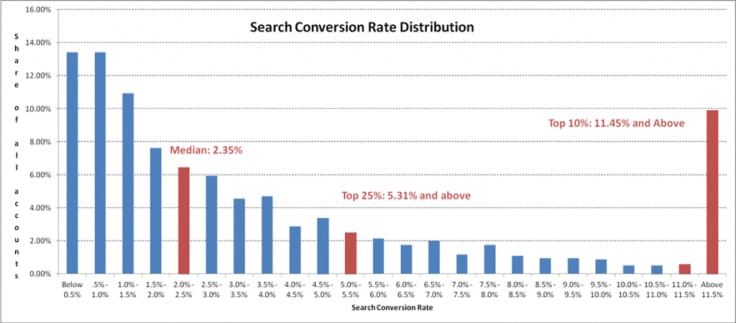
WordStream analyzed hundreds of AdWords accounts across all industries - with a combined $3 billion in annual spend. They checked that 25% of all examined accounts had a conversion rate lower than 1%, while the top performing accounts reached conversion rate of 5.31% and higher. The median of all accounts was 2.35%.
So good conversion rate actually depends on your ambition. Who you want to compare yourself with? What is your benchmark - the average players or top performing sites?
Does being average is okay for you? Hope not ;-) always aim high.
Of course, besides, you should remember that the conversion rate is highly contextual and varies by industry and product types. Online shops selling high-end electronics won’t get similar conversion rates to, let’s say, grocery shops.
Some other variables that determine conversion rates include:
- product cost or average order value
- location
Take a look at e-commerce conversion rates by product type and industry, provided by MarketingSherpa E-commerce Benchmark Study.
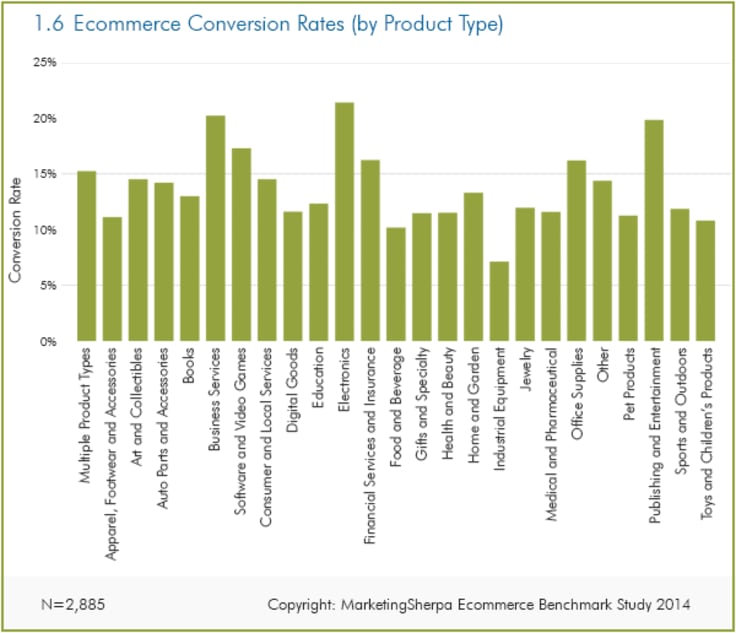
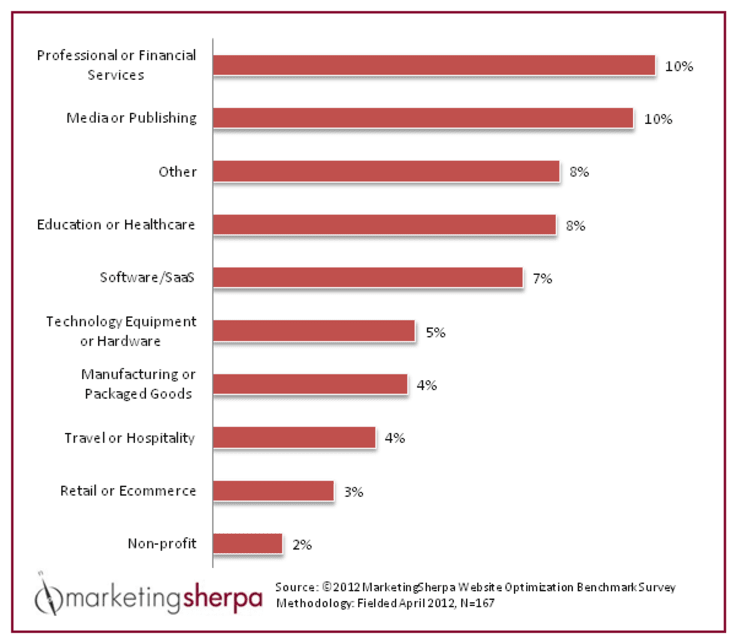
I’ve also found a Business2Community resource about conversion rates of some freemium providers such as Spotify and Dropbox.
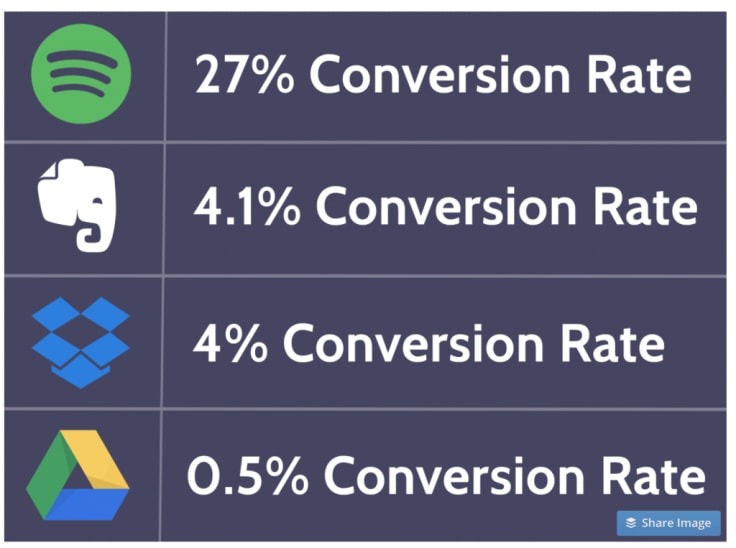
PS: There is only one freemium provider that outranks Spotify, and that’s Slack with its 30% conversion rate. But bear in mind that Slack is a B2B solution while Spotify is B2C and young people around 13-18 years old comprise the primary user segment.
If you are trying to reach conversion stars follow Spotify and Slack carefully and observe any new releases rolling out. Perhaps, you’ll spot something worth putting to use on your own website ;-).
I’m not saying that stealing others’ ideas is a good approach though, but having great inspirations is quite motivating. Besides, don’t expect the same forms of optimization will to resonate similarly in your business niche. Each project is an individual case.
Raising conversion rates is vital to your business because it allows you increase the bottom line and sale more on the same traffic levels your website currently receives. Each site has its own conversion funnel a visitor moves through during their buyer’s journey with you, changing from a complete stranger to a customer, to finally becoming your brand’s advocate.
Conversion happens on each stage of your funnel.
Conversion Funnel
Below you’ll find the AIDA graph that mirrors how the shape of a conversion funnel for looks like.
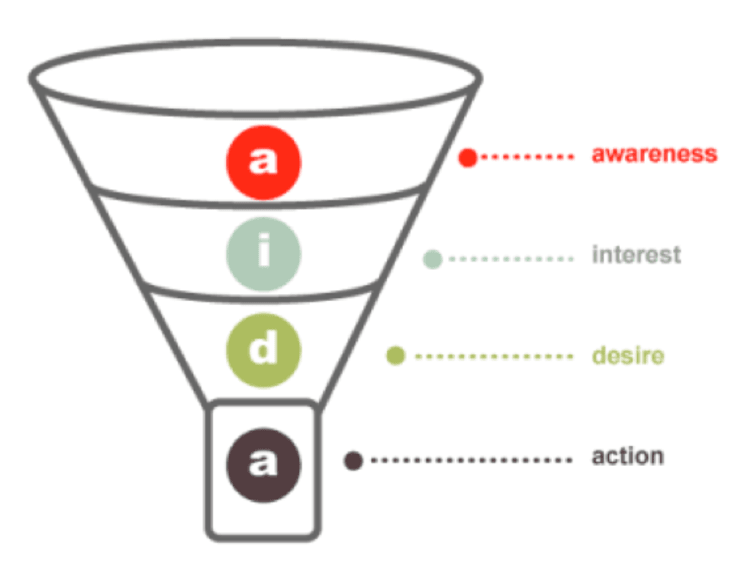
Based on it, there has been developed 3 main stages in the buyer’s journey.
What is Buyer’s Journey
Buyer’s Journey is the entire process a user goes through on your site to finally complete it with a purchase. It narrows down into three stages. Becoming aware, considering solutions and making a final call.

Credits: HubSpot
1. The Awareness Stage
This is the first stage of your buyer’s journey. The awareness stage is all about bringing visitors to your site. It’s the very beginning of a buyer’s journey so that your potential buyer is most likely not aware of your company and what an exact need should be fulfilled. All the prospect knows is that something isn’t right and they want to chance it.
In practice, the process looks like this:
- The Internet user types their nurturing questions into google search box.
- During research, a user discovers YOU among other results in the SERPs.
Online research is what brings them to your site and your resources. Most often, a new visitor lands on your educational materials at this stage, such as:
- blog posts
- how to guides
- ebooks
- or one of your landing pages
because they’re optimized for phrases users, call out.
Take a searcher who is looking for ways to improve overall health.
During the awareness stage, the user begins to do research and reads several articles covering health treatment and finally understands that if he easily gets sick, then there might be a more complicated reason behind it. There might be something wrong with his immune system. The user finds out that he needs to do blood tests to detect any diseases or disorders that may interfere with the immune system.
This is what awareness stage is for.
In the course of doing research, you, as a buyer, become aware of a pain point you might really have and look for ways to tackle it.
2. The Consideration Stage
This is a second stage in the overall conversion process and comes right after the internet user becomes aware of having specific trouble. The consideration stage, in other words, is called the Research or Evaluation stage. For 72% of buyers, they’ll turn to Google and start broad. Now, when a user gets hooked on a given topic, digs deeper and explore various options to solve his health issue.
Let’s say, the searcher scans on a few resources that encourage him to do blood tests at the clinic nearby, besides he reads further and finds out that there are also ways to boost their immune system naturally by taking supplements and nourishing themselves with specific nutrients through a particular diet. Also, he might find out that they need a warm sweater, a coat and a scarf for autumn chills to protect himself from wind and cold temperatures.
In this case, the consideration stage is the process of digging deeper, discovering various options to tackle health issues and thinking them over. This is a stage of digesting the issue and analyzing if the ideas are worth the effort.

The consideration stage can last from a few hours to even a whole year. It really depends on what product we talk about. A lot of factors in. Not always can your prospect afford some pricey solution right away, this is why they often need to save money or even wait for a raise before he can go for it.
3. Decision Stage
Finally, once research is done, and all the ideas around the given trouble are thought through the time comes for the user to make a decision.
In this stage, a user from our example goes for blood tests to the nearby clinic, orders dedicated supplements and goes for a diet that contains all recommended nutrients to boost his immune system. More, he orders a proper coat, scarf and even few sweaters to tackle his health issue comprehensively.
The decision stage is tied to goal completion.
Here, your prospect is finally ready for purchase, completes the buyer’s journey, and goes to the very end of the entire conversion process.
Ok, that’s what each stage of the typical buyer’s journey looks like!
Back to you
Now, let’s figure out how actually this theory can translate to your own business environment.
A good idea would be to interview both your customers, prospects as your sales team too.
Try to find right answers to these questions:
- How do our buyers describe their challenges and goals?
- How do buyers get educated on their challenges and goals?
- What common misconceptions might buyers have addressing their challenges and goals?
- How do your buyers perceive the pros and cons of each solution?
- How do buyers decide what solution is right for them?
- What criteria do buyers use to evaluate the available solutions?
These are only a few questions that should be asked on the way to characterize the buyer's journey on your site entirely.
Once you gather all the answers, you will be able to define your own buyer's journey and become more aware of the processes your prospects undergo on their way to acquire your solutions.
The better understanding towards your buyer’s journey you get, the better you can actually convert your site’ visitors into customers, optimizing any leverage point that occurs to be vital.
Final Thought
Above all, bear in mind that every single page always should pursue a single goal, push and prompt to conversion.
Each page of your site that you build and communication you establish is a part of the broader process. It should fit into and complement website’s integrity so that your online presence would represent the consistent identity and stick to the overall marketing strategy.
This is what you should remember while designing your site and creating your content.
Let’s say, the conversion process can be compared to building a house.
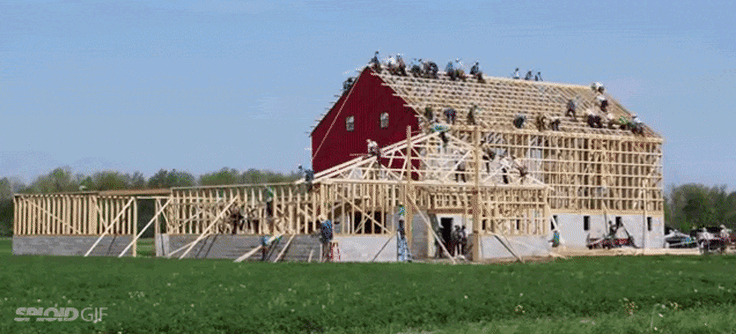
You should have your vision granularly planned and stick to the construction project. Only the precisely implemented project will guarantee the desired shape of a building that is safe and solid at the same time.
A well-optimized conversion funnel is a critical thing to your overall online marketing success.
Marketing that you build with your online presence and campaigns should be tied to a single and superior goal - that is driving relevant conversions for the given stage of buyer's journey.
And do you design your online marketing strategy based on the bigger perspective made by conversion funnel? Get in touch with me via Twitter and let me know.
Happy Marketing Guys!
Kasia



